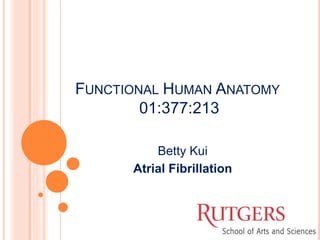
Atrial Fibrillation Case Study
- 1. FUNCTIONAL HUMAN ANATOMY 01:377:213 Betty Kui Atrial Fibrillation
- 2. SUMMARY OF THE INJURY Atrial fibrillation (AF) is the most common type of arrhythmia that occurs when rapid disorganized electrical signals cause the atria to quiver This causes a fast and irregular heart rhythm and prevents proper blood flow through heart
- 3. SUMMARY OF INJURY People with AF may not exhibit symptoms Severe fibrillation can cause chest pain, increase risk of stroke, and heart failure if heart rhythm is very rapid
- 4. PATIENT PRESENTATION 78 year old male patient complaining of fatigue, dizziness, and chest pain during his weekly run.
- 5. RELEVANT CLINICAL FINDINGS The patient exhibits these symptoms periodically in his recent past two morning jog sessions. Thinking it was due to dehydration, he drank water after each episode but found no relief. He says he has considerable fitness as he enjoys running or swimming 2 hours every morning. His family has no history of heart disease but has a history of hypertension.
- 6. RELEVANT CLINICAL FINDINGS: PHYSICAL EXAM/ TEST Vitals taken upon visit are BP: 160/92 HR: 128 bpm (irregular) Respiration rate: 17 bpm Lung: Decreased lung sounds Additional findings: Swelling of feet
- 7. RELEVANT CLINICAL FINDINGS: LAB TESTS CBC and Urinalysis No abnormalities TSH blood test TSH and T4 levels are normal ruling out hyperthyroidism
- 8. RELEVANT CLINICAL FINDINGS: IMAGING STUDIES Electrocardiogram (ECG) Results indicate irregular heartbeat Echocardiogram Results show blood pooling in atria, improper blood flow Chest x-ray Indication of possible fluid found in lungs
- 9. CLINICAL PROBLEMS TO CONSIDER Based on history, chief complaint, and findings from examination, other possible diagnosis can be Chronic obstructive pulmonary disease (COPD) Pulmonary embolism Ventricular hypertrophy
- 10. RELEVANT ANATOMY: HEART The heart is the central part of the circulatory system. Each heartbeat pumps blood through the arteries to the rest of the body and returns to the heart via the veins. Heart consists of 4 chambers: 2 upper atria (left and right) 2 lower ventricles (left and right)
- 11. RELEVANT ANATOMY: HEART IN AF PATIENTS AF patients’ atria get bombarded with electrical signals from the SA node causing atria to quiver as these signals are trying to pass into the ventricles through the AV node AF patients’ ventricles also beat rapidly but not as rapidly as their atria
- 12. RELEVANT ANATOMY: HEART IN AF PATIENTS This results in a fast and irregular heart rhythm Normal heart rate 60-100bpm AF patient heart rate 100-175bpm We can identify this difference in the irregularity of heart relaxations and contractions in an AF patient’s EKG
- 13. RELEVANT ANATOMY: VALVES OF THE HEART 2 types: Atrioventricular (AV) valves: between atria and ventricles Valves open as ventricles relax (diastole) Valves close when blood accumulates and ventricles contract (systole) Semilunar valves: between ventricles and vessels Valves open as ventricles contract (systole) Valves close as blood volume decreases and ventricles relax (diastole) Abnormal heart valves are a pre-disposing factor for AF
- 14. RELEVANT ANATOMY: PULMONARY EMBOLISM Pulmonary embolism occurs when a clump of material, usually a blot clot, forms a blockage within blood vessels in the lungs These clots usually originate in deep veins of legs but can also come from other parts of the body’s circulation system
- 15. RELEVANT ANATOMY: PULMONARY EMBOLISM 2 Types of Blood Circulation: Systemic: arteries carry oxygenated blood from heart to rest of body, veins return deoxygenated blood to heart Begins at left ventricle, leaves aorta, and ends at right atrium Pulmonary: arteries carry de-oxygenated blood from heart to lungs, veins return oxygenated blood to heart
- 16. RELEVANT ANATOMY: PULMONARY EMBOLISM Blood flow through the heart and body: Right atrium Tricuspid valve Right ventricle Pulmonary semilunar valve Pulmonary artery Left and right pulmonary arteries Lungs Left and right pulmonary veins Left atrium; Bicuspid valve; Left ventricle; Aortic semilunar valve; Aorta Arteries Capillaries Veins Superior and inferior vena cava Right atrium
- 17. CLINICAL REASONING: COPD Signs and Symptoms Shortness of breath Chest tightness Chronic cough producing white/clear/yellow/green sputum Frequent respiratory infections Pre-disposing Factors Frequent tobacco smoking Constant exposure to air pollution/ fumes Deficiency of alpha-1 antitrypsin protein
- 18. CLINICAL REASONING: PULMONARY EMBOLISM Signs and Symptoms Shortness of breath Chest pain Cough with bloody sputum Leg swelling Pre-disposing Factors History of cardiovascular disease Metastatic cancers like pancreatic, ovarian, or lung cancer Prolonged immobility increasing chance of blot clots forming
- 19. CLINICAL REASONING: VENTRICULAR HYPERTROPHY Signs and Symptoms Shortness of breath Chest pain Dizziness or fainting Sensation of rapid fluttering/pounding heartbeats (palpitations) Pre-disposing Factors Frequent smoker Overweight Have a condition that increases risk of hypertension Ex. Hypertrophic cardiomyopathy, a genetic condition in which the heart muscle is abnormally thick making it harder to pump blood
- 20. REFERENCES Holland K. Atrial Fibrillation Blood Clots: Symptoms, Prevention, and More. Healthline. 2016. http://www.healthline.com/health/atrial-fibrillation-blood-clots. Accessed February 20, 2016. Rosenthal L. Atrial Fibrillation Workup: Approach Considerations, Electrocardiography, Lab Studies. Emedicinemedscapecom. 2016. http://emedicine.medscape.com/article/151066-workup. Accessed February 19, 2016. Sinha S. Clinical Case: New-Onset Atrial Fibrillation.MedPage Today. 2016. http://www.medpagetoday.com/resource- center/managing-afib/new_onset_clinical_case/a/35443. Accessed February 20, 2016. What Is Atrial Fibrillation? - NHLBI, NIH. 2016. https://www.nhlbi.nih.gov/health/health-topics/topics/af. Accessed February 20, 2016.